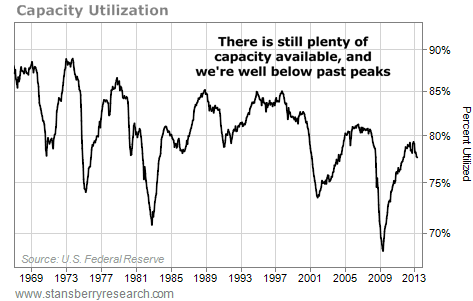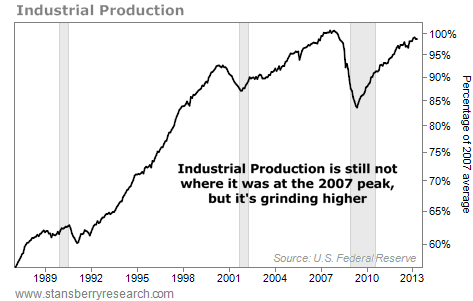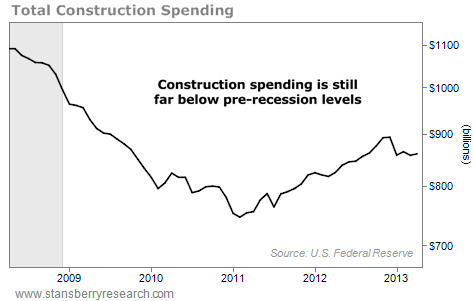 Here’s the No. 1 worry I’m hearing from my family, my friends, and my readers… especially folks who are in or nearing retirement…
Here’s the No. 1 worry I’m hearing from my family, my friends, and my readers… especially folks who are in or nearing retirement…
“I’m worried about all this government spending producing rampant inflation… and ruining my savings.”
My regular readers know that as a doctor, I try to focus on facts and take emotions out of trading and investing. So today… we’re going to stand back and take a look at what’s really happening with the economic data.
[ad#Google Adsense 336×280-IA]Once we look at what the numbers are telling us about the economy, we can start to plan our investments… and our retirements.
One of my favorite “armchair economist” statistics is “capacity utilization.”
It’s simply the percent of manufacturing capacity being used to make things in the U.S.
When utilization is lower, manufacturers have more capacity available.
This helps keep pricing pressure low.
And although capacity utilization has increased to the high 70% level, it’s still below past peaks and is holding below the low 80% range, where we start to feel some pricing pressures.
 Another related number is “industrial production.” This tracks output from the manufacturing, mining, and gas and electric utilities in the United States.
Another related number is “industrial production.” This tracks output from the manufacturing, mining, and gas and electric utilities in the United States.
When industrial production is flat or slightly rising, that’s good news for the economy and consumers. It means things are moving slowly, but prices can remain low.
The chart below signals a steadily improving economy, but not yet at the past peak. And with a flat slope, there’s little worry about pricing pressures.
 With the industrial and manufacturing sectors holding steady, a look at weekly wages gives us a clue as to whether workers can put pressure on the economic flow of money.
With the industrial and manufacturing sectors holding steady, a look at weekly wages gives us a clue as to whether workers can put pressure on the economic flow of money.
Consumers with more money tend to go out and spend it. And if wage costs go up too fast, businesses pass that on to consumers in the prices of goods and services. Wage data tell us if money is flowing into people’s pockets fast enough to stimulate either demand or cost inflation.
But as you can see below, the average weekly earnings for workers in the U.S. hasn’t grown much over the past year. In fact, the rate of increases looks like it may be slowing.
Workers are still getting a little bit more every week, but they’re unlikely to run out and drive prices up at the local store or car showroom.
 In normal economic cycles, we’d expect some major industries to return to previous high levels of investment and production… A quick glance at construction spending gives us a sickly report on this important piece of the non-service economy.
In normal economic cycles, we’d expect some major industries to return to previous high levels of investment and production… A quick glance at construction spending gives us a sickly report on this important piece of the non-service economy.
Money spent on construction has picked up over the last two years. But it’s still far below what was being spent prior to and during the recession. And worse, it’s starting to struggle a bit lately.
 In sum… the economy is still chugging along… but slowly. I’m seeing few signs of price inflation from either the cost or demand sides.
In sum… the economy is still chugging along… but slowly. I’m seeing few signs of price inflation from either the cost or demand sides.
That’s why I’m telling my readers to keep using the strategies that have generated double-digit annual returns for the last three years…
Buy rock-solid dividend-payers that will survive in good times and bad… put a portion of your portfolio in safe, fixed-income assets, like municipal bonds… keep a small amount of money in “chaos hedges,” like gold and silver… and sell options on cheap, high-quality businesses.
Over the long term, the government’s spendthrift policies will lead to trouble. But the facts say that right now, it’s not a concern. So we’re sticking to the plan.
Here’s to our health, wealth, and a great retirement,
Dr. David Eifrig
[ad#stansberry-ps]
Source: DailyWealth

